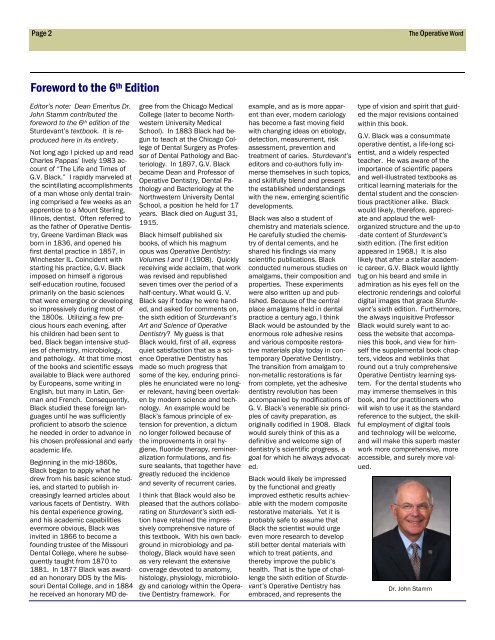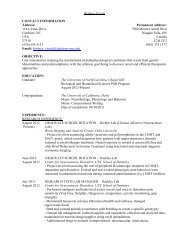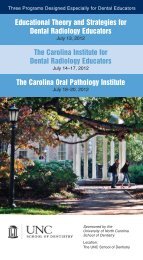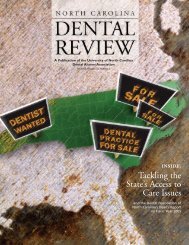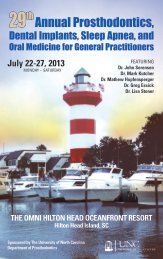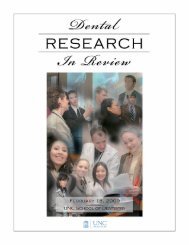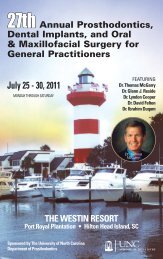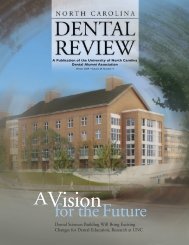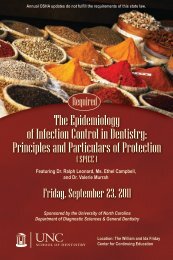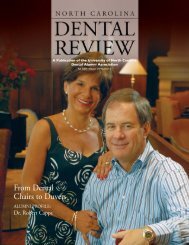The Operative Word - UNC School of Dentistry - The University of ...
The Operative Word - UNC School of Dentistry - The University of ...
The Operative Word - UNC School of Dentistry - The University of ...
You also want an ePaper? Increase the reach of your titles
YUMPU automatically turns print PDFs into web optimized ePapers that Google loves.
Page 2<strong>The</strong> <strong>Operative</strong> <strong>Word</strong>Foreword to the 6 th EditionEditor’s note: Dean Emeritus Dr.John Stamm contributed theforeword to the 6 th edition <strong>of</strong> theSturdevant’s textbook. It is reproducedhere in its entirety.Not long ago I picked up and readCharles Pappas’ lively 1983 account<strong>of</strong> “<strong>The</strong> Life and Times <strong>of</strong>G.V. Black.” I rapidly marveled atthe scintillating accomplishments<strong>of</strong> a man whose only dental trainingcomprised a few weeks as anapprentice to a Mount Sterling,Illinois, dentist. Often referred toas the father <strong>of</strong> <strong>Operative</strong> <strong>Dentistry</strong>,Greene Vardiman Black wasborn in 1836, and opened hisfirst dental practice in 1857, inWinchester IL. Coincident withstarting his practice, G.V. Blackimposed on himself a rigorousself-education routine, focusedprimarily on the basic sciencesthat were emerging or developingso impressively during most <strong>of</strong>the 1800s. Utilizing a few precioushours each evening, afterhis children had been sent tobed, Black began intensive studies<strong>of</strong> chemistry, microbiology,and pathology. At that time most<strong>of</strong> the books and scientific essaysavailable to Black were authoredby Europeans, some writing inEnglish, but many in Latin, Germanand French. Consequently,Black studied these foreign languagesuntil he was sufficientlypr<strong>of</strong>icient to absorb the sciencehe needed in order to advance inhis chosen pr<strong>of</strong>essional and earlyacademic life.Beginning in the mid-1860s,Black began to apply what hedrew from his basic science studies,and started to publish increasinglylearned articles aboutvarious facets <strong>of</strong> <strong>Dentistry</strong>. Withhis dental experience growing,and his academic capabilitiesevermore obvious, Black wasinvited in 1866 to become afounding trustee <strong>of</strong> the MissouriDental College, where he subsequentlytaught from 1870 to1881. In 1877 Black was awardedan honorary DDS by the MissouriDental College, and in 1884he received an honorary MD degreefrom the Chicago MedicalCollege (later to become Northwestern<strong>University</strong> Medical<strong>School</strong>). In 1883 Black had begunto teach at the Chicago College<strong>of</strong> Dental Surgery as Pr<strong>of</strong>essor<strong>of</strong> Dental Pathology and Bacteriology.In 1897, G.V. Blackbecame Dean and Pr<strong>of</strong>essor <strong>of</strong><strong>Operative</strong> <strong>Dentistry</strong>, Dental Pathologyand Bacteriology at theNorthwestern <strong>University</strong> Dental<strong>School</strong>, a position he held for 17years. Black died on August 31,1915.Black himself published sixbooks, <strong>of</strong> which his magnumopus was <strong>Operative</strong> <strong>Dentistry</strong>:Volumes I and II (1908). Quicklyreceiving wide acclaim, that workwas revised and republishedseven times over the period <strong>of</strong> ahalf-century. What would G. V.Black say if today he were handed,and asked for comments on,the sixth edition <strong>of</strong> Sturdevant’sArt and Science <strong>of</strong> <strong>Operative</strong><strong>Dentistry</strong>? My guess is thatBlack would, first <strong>of</strong> all, expressquiet satisfaction that as a science<strong>Operative</strong> <strong>Dentistry</strong> hasmade so much progress thatsome <strong>of</strong> the key, enduring principleshe enunciated were no longerrelevant, having been overtakenby modern science and technology.An example would beBlack’s famous principle <strong>of</strong> extensionfor prevention, a dictumno longer followed because <strong>of</strong>the improvements in oral hygiene,fluoride therapy, remineralizationformulations, and fissuresealants, that together havegreatly reduced the incidenceand severity <strong>of</strong> recurrent caries.I think that Black would also bepleased that the authors collaboratingon Sturdevant’s sixth editionhave retained the impressivelycomprehensive nature <strong>of</strong>this textbook. With his own backgroundin microbiology and pathology,Black would have seenas very relevant the extensivecoverage devoted to anatomy,histology, physiology, microbiologyand cariology within the <strong>Operative</strong><strong>Dentistry</strong> framework. Forexample, and as is more apparentthan ever, modern cariologyhas become a fast moving fieldwith changing ideas on etiology,detection, measurement, riskassessment, prevention andtreatment <strong>of</strong> caries. Sturdevant’seditors and co-authors fully immersethemselves in such topics,and skillfully blend and presentthe established understandingswith the new, emerging scientificdevelopments.Black was also a student <strong>of</strong>chemistry and materials science.He carefully studied the chemistry<strong>of</strong> dental cements, and heshared his findings via manyscientific publications. Blackconducted numerous studies onamalgams, their composition andproperties. <strong>The</strong>se experimentswere also written up and published.Because <strong>of</strong> the centralplace amalgams held in dentalpractice a century ago, I thinkBlack would be astounded by theenormous role adhesive resinsand various composite restorativematerials play today in contemporary<strong>Operative</strong> <strong>Dentistry</strong>.<strong>The</strong> transition from amalgam tonon-metallic restorations is farfrom complete, yet the adhesivedentistry revolution has beenaccompanied by modifications <strong>of</strong>G. V. Black’s venerable six principles<strong>of</strong> cavity preparation, asoriginally codified in 1908. Blackwould surely think <strong>of</strong> this as adefinitive and welcome sign <strong>of</strong>dentistry’s scientific progress, agoal for which he always advocated.Black would likely be impressedby the functional and greatlyimproved esthetic results achievablewith the modern compositerestorative materials. Yet it isprobably safe to assume thatBlack the scientist would urgeeven more research to developstill better dental materials withwhich to treat patients, andthereby improve the public’shealth. That is the type <strong>of</strong> challengethe sixth edition <strong>of</strong> Sturdevant’s<strong>Operative</strong> <strong>Dentistry</strong> hasembraced, and represents thetype <strong>of</strong> vision and spirit that guidedthe major revisions containedwithin this book.G.V. Black was a consummateoperative dentist, a life-long scientist,and a widely respectedteacher. He was aware <strong>of</strong> theimportance <strong>of</strong> scientific papersand well-illustrated textbooks ascritical learning materials for thedental student and the conscientiouspractitioner alike. Blackwould likely, therefore, appreciateand applaud the wellorganizedstructure and the up-to-date content <strong>of</strong> Sturdevant’ssixth edition. (<strong>The</strong> first editionappeared in 1968.) It is alsolikely that after a stellar academiccareer, G.V. Black would lightlytug on his beard and smile inadmiration as his eyes fell on theelectronic renderings and colorfuldigital images that grace Sturdevant’ssixth edition. Furthermore,the always inquisitive Pr<strong>of</strong>essorBlack would surely want to accessthe website that accompaniesthis book, and view for himselfthe supplemental book chapters,videos and weblinks thatround out a truly comprehensive<strong>Operative</strong> <strong>Dentistry</strong> learning system.For the dental students whomay immerse themselves in thisbook, and for practitioners whowill wish to use it as the standardreference to the subject, the skillfulemployment <strong>of</strong> digital toolsand technology will be welcome,and will make this superb masterwork more comprehensive, moreaccessible, and surely more valued.Dr. John Stamm


